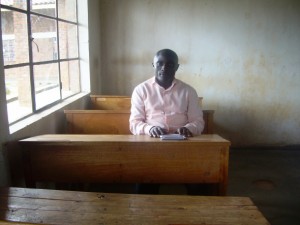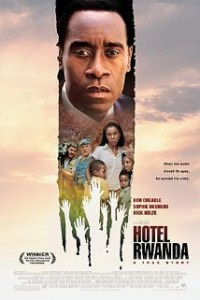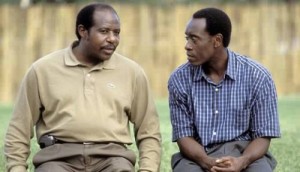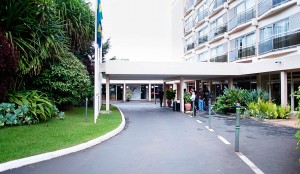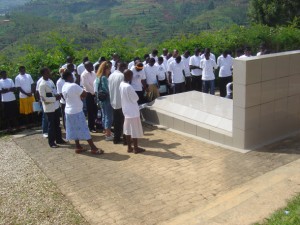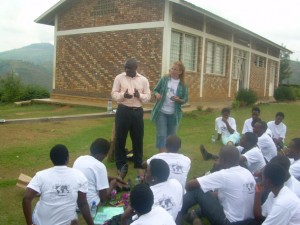“Truly I tell you, wherever this good news is proclaimed in the whole world, what she has done will be told in remembrance of her.” [Matthew 26:13, NRSV]
[L] Stained glass window, Mary Anointing Jesus’ Feet. [M] Sister Félicitée Niyitegeka. [R] Phanuel sits at the desk where he was that fateful evening.
Jesus came to interrupt the violence in the death-bound human condition and to give hope for new life. Mary of Bethany, known for sitting at the feet of Jesus and listening intently to his every word, knew ahead of others the need to interrupt the ultimate violence that would be committed against him. Her interruption at a dinner gathering, graphically described in Matthew 26 and John 12, was an outrageously generous anointing of Jesus, in preparation for his coming violent passion and death. Silencing the male disciples who, without the foggiest idea of what was going on at this anointing but were making snide remarks against her, Jesus said to them:
- “Truly, I say to you, wherever this gospel is preached in the whole world, what she has done will be told in memory of her.” [Matthew 26:13]
Against the murderous acts of genocidal violence in Rwanda, there were heroic acts of sacrificial love. Many individuals have gone out of their way to side with the innocents, sheltering them, risking their lives for them. They were participating in the divine acts of interruption against violence, for the sake of God’s children. In the face of darkness and death, they offered signs of hope and the promise of new life. They embodied prophetic interruptions in Rwanda during her darkest hour. Their stories, integrated into our modern day preaching of the gospel, must be told in memory of them. We recall a few such stories.
1. Paul Rusesabagina of Hôtel des Mill Collines
Thanks to the 2004 movie Hotel Rwanda, the incredible work of Paul Rusesabagina with a Tutsi wife, has become well known. Dubbed the African Schindler’s List, this movie documents Rusesabagina’s acts as temporary manager of the besieged Hôtel des Mille Collines, to shelter his family and more than a thousand Tutsis from being slaughtered by the interahamwe militia. In his book, Mirror to the Church, Emmanuel Katongole makes a critical comment:
- “We should pay careful attention to the fact that, in the midst of genocide, an international hotel offered more good news than the nearest church. Indeed, the Hôtel des Mille Collines offers an example of what the church is called to be – a hopeful interruption to the death-bound reality of a broken world.”
Two years later, faced with credible threats on his life, he applied for political asylum in Belgium and moved to Brussels in 1996. For his courageous acts in interrupting violence during the genocide, he received the President’s Freedom Award.
[L & M] Paul Rusesabagina and Don Cheadle. [R] Hôtel des Mille Collines.
2. Sister Felicitee
In their book titled Tribute to Courage, the African Rights organization researched and told stories of abuses and courage in many countries in Africa. Of the Rwandan genocide, it says:
- “The intensity of the violence that exploded in Rwanda in April 1994 was overwhelming. Many Rwandese who did not condone the genocide may have either felt there was nothing they could do to prevent it or have simply been paralysed by fear. There were those, however, who were armed with unfailing courage and humanity and did everything they could to save lives. This book tells the stories of some of the men and women who fought to protect others. Survivors describe their experiences and speak of their feelings for the people who saved them. These are moving records of fear and gratitude, of human triumphs in the face of catastrophe.”
One of those stories the book documented was that of Sister Félicitée Niyitegeka, a Hutu member of the Auxiliaries of the Apostolate, a religious order of the Catholic Church in Rwanda.
- “Despite the pleas of her brother, a senior army officer, and his offer of help, Sister Félicitée would not desert the frightened people who flooded to the St Pierre Centre in Nyundo, Gisenyi which she had helped establish. She gave them food, medical care and advice and evacuated the most vulnerable to Zaire. When the militia abducted them, she accompanied them. Then she too was murdered.”
Fr. Emmanuel Katongole is especially fond of the memory of this saintly Sister who “embodies the prophetic posture” and “improvised a powerful interruption”. Of her, he wrote in Mirror to the Church:
- “To the very end, she dared to question the line between her and the militia leader by praying that God would have mercy on him. In Rwanda Sister Felicite has been given the title ‘hero of the nation.’ May be ‘hero’ is the best language nations have for naming the gifts given them by God. But in the church, we call Sister Felicite a saint and a martyr. ”
3. The Small Muslim Community at Nyamirambo
During the trip, we were shown a small Muslim community with its big story of genocide interruption. This is the Muslim community of Nyamirambo on the outskirts of Kigali. In the face of the interahamwe who were armed to the teeth, menacingly threatening death and ordering a racial segregation for identification and slaughter, they refused to divide between Hutus and Tutsis.
Living in the margins of Rwandan society as a small minority, and at a slum area whose name means “a place of death”, it is a marvel to say the least that this community embodies a story of persistent existence as an interruption to the mad violence of genocide.
The truth was not lost on us that their very marginal existence has opened this small minority Muslim community to better appreciate the heart of the compassionate God of the margins than the larger community had. While the Christian churches at the time of the genocide had largely left it to their individual members to struggle with their conscience, therefore, this marginal Muslim community stuck together, prioritizing God, faith and unity above narrow tribal grievances, to protect their Tutsi members. It was truly a sad commentary on an overwhemingly Christian society [the 2006 figures showed 94% of the Rwandans were Christian] that had to rely on a small Muslim community, which found itself in marginal existence, to alone resonate so completely what the Lord Jesus prayerfully reported to the Father:
- “Of those whom thou gavest me I lost not one” [John 18:9].
4. Students at Nyange Secondary School
This conscious choice to protect “the other” as “one of our own” was the deeply inspiring story we heard at the Nyange Secondary School, the site of a pristine single-tomb genocide memorial.
Recall that this is the same Nyange we wrote about in a previous post [post No. 94] where a priest orchestrated the extermination of a few thousand parishioners in the very church of which he was the pastor. Imagine the shocking contrast: secondary school students dying for Kingdom-advancement “on earth as it is in heaven” in utter obedience to the will of God, while an ordained minister of the Church, despite all that the official Church claims of his conformity to Christ on account of his ordination, acted in utter obedience to the devil.
The story did not take place in 1994, but in 1997, three years after the genocide. On 18 March 1997, a band of Hutu insurgents attacked this hilltop boarding school under the cover of darkness, killing a night watchman and six students and seriously wounding twenty others. The twenty or so gunmen, all donning army fatigue, had infiltrated Rwanda from the safety of the refugee camps in the former Zaire. Intent on killing all of the school’s Tutsis, they were frustrated by the 5th and 6th grade students who were doing evening studies in two classrooms. Refusing to separate by racial identification, those students insisted, “We are all Rwandans” [“Twese Turi abanyarwanda]. For that, their punishment was death.
One of the students killed was Chantal Mujawamahoro, the sole victim interred in the tomb on the school grounds. Stories told by students who survived that evening’s mad killing recalled Chantal telling the gunmen:
- “We do not have Hutus or Tutsis here, we are Rwandans.”
She was the only victim whose body was not claimed by relatives in time and was thus buried on the school ground. All the students murdered during this single evening of post-genocide killing were honored as national heroes.
To stare death in the face and play hero is not an everyday story. What gave the students such “superhuman” courage? In his book, Fr. Emmanuel pointed to a possible contributory reason. Every morning before class, one of the teachers teaching a course on unity and non-violence would tell the students stories about Martin Luther King and Mahatma Gandhi.
- “The evening prayer and a talk here and there on nonviolence – we don’t think of such acts as witnesses to resistance and defiance. But in a world so enamored with grand strategies to end poverty and eradicate terrorism, Nyange reminds us that resistance is about small acts and gestures – a story here, a lesson there.”
The stories of those brave students, repeatedly told in schools across the nation, have inspired many youths to initiate the formation of peace clubs. Teachers, conscious that the best lessons in life are not learned in classrooms but on field trips, hold peace camps and take students to visit the Kigali Memorial Centre and the Nyange Secondary School. The witness of the students at Nyange is immensely powerful, especially for the youths in this country. Their story of heroism on that fateful evening can teach, inspire and form the youths more than any teacher can, about the goodness of humanity and co-humanity, and the feasibility of peace and non-violence. These youths will go on to work on peace camps for racial acceptance and reconciliation. The death and suffering of the victims have generated real hope and brought new life. It was exceptionally heart-warming and faith-growing to see and hear all that.
[L] Students on field trip visit praying at Chantal’s tomb. [R] Visiting students on a field trip to the school at Nyange.
5. Widows Banding for Immense Good
The above stories tell of some of the many signs of immense hope in the midst of violence and death in Rwanda. As we observed the ongoing effects of the powerful witness of the students at Nyange, our minds naturally turned to other signs of hope for the ongoing healing and hopeful existence of pained and hurting survivors, especially widows and young children. It warms hearts to hear about myriad initiatives, some organizing for peace and reconciliation, and others offering concrete help where help is urgently needed. One such organisation is Avega.
Faced with myriad problems after the 1994 genocide – psychological, social, economic, political and financial needs – 50 widows banded together to form Avega in 1995. They offered each other mutual support and, with group encouragement, they began to learn skills and grow in self-esteem, confidence and hope for the future. They have tasted profound change and, most crucially, they know that to rebuild their lives after the genocide is truly feasible. From being widows who were forlorn, engulfed by severe trauma and loneliness, and many feeling altogether lost as to what to do to move on in life, they have learned to stand on their own feet and gone on to help others. Having experienced the power of love and solidarity, they have reached out to share that love and solidarity. Not only have they risen from the ashes, but they have gone on to care for more than 70,000 orphans. They manifest for us in the concrete what we can only teach in theology about authentic freedom and co-humanity. Having suffered dire needs, these women of faith could better understand the needs of others, and they have assumed their responsibility to help motivate the less fortunate.
In Rwanda today, we see myriad initiatives by women to turn the fallout of post-genocide paralysing darkness into valiant work of Kingdom-advancement. We are mighty impressed. We are grateful for the opportunity to see this affirmation of the fundamental human goodness that has not been snuffed out by evil. Above all, we are grateful for the privilege to “feel” and “touch” the journey of those who once suffered so grossly and yet have managed to progress so valiantly from pain to hope.
Copyright © Dr. Jeffrey & Angie Goh, January 2014. All rights reserved.
You are most welcome to respond to this post. Email your comments to us at jeffangiegoh@gmail.com. You can also be dialogue partners in this Ephphatha Coffee-Corner Ministry by sending us questions for discussion.



